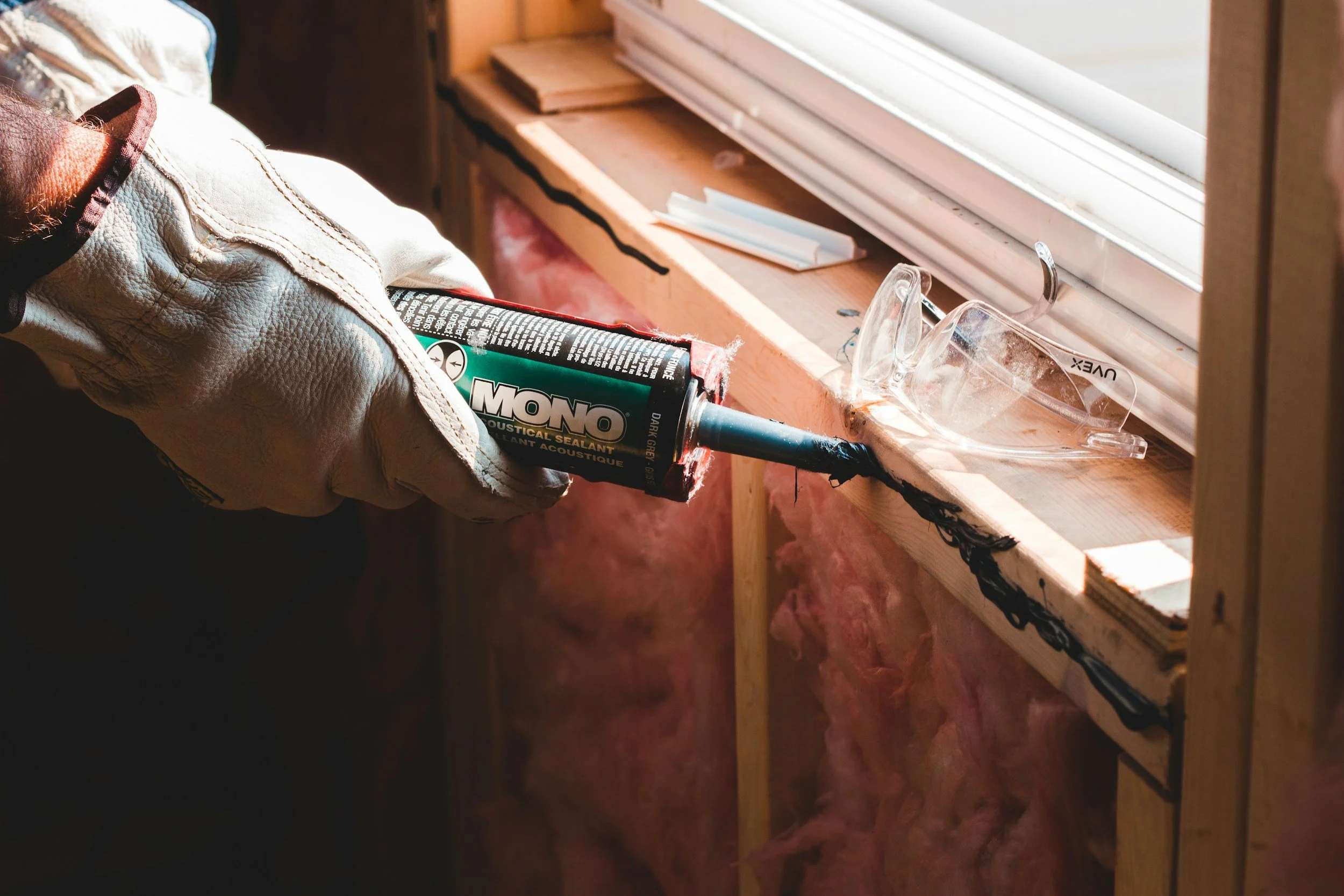The Hidden Chemicals in Building Materials
Most people are shocked to learn that their homes — the places they expect to be the safest — can harbor hidden chemicals that impact their health every day.
The EPA estimates Americans spend about 90% of their time indoors [1], and studies show that indoor air can be two to five times more polluted than outdoor air [2].
Much of that pollution comes from volatile organic compounds (VOCs) and other hazardous chemicals released from building materials, furnishings, and everyday household products. These chemicals can off‑gas for months — even years — after installation or purchase, and many have been linked to respiratory problems, hormone disruption, and even cancer.
Let’s explore the top offenders, where they’re hiding, and how you can reduce your exposure.
What Are VOCs?
VOCs (Volatile Organic Compounds) are carbon‑based chemicals that easily evaporate into the air at room temperature.
They’re used in a wide range of products — from paints and adhesives to flooring and furniture.
While VOCs can occur naturally (for example, in pine trees), many synthetic VOCs found indoors are far from harmless.
Some evaporate quickly; others linger for years, continually releasing toxic compounds into the air you breathe.
Top 5 Chemicals of Concern in Homes
1. Formaldehyde
Where it’s found: Engineered wood products (MDF, particleboard, plywood), cabinetry, flooring, textiles, paints.
Health risks: Eye, nose, and throat irritation, asthma, cancer [3].
Why it’s a problem: Highly volatile with a low boiling point; off‑gasses even at cold temperatures.
Tip: Choose solid wood furniture or products labeled as formaldehyde‑free.
2. Benzene
Where it’s found: Paints, adhesives, cleaning products, gasoline fumes (from attached garages).
Health risks: Known human carcinogen linked to leukemia and blood cancers [4].
Tip: Avoid storing gasoline or fuel‑powered tools indoors. Use water‑based products whenever possible.
3. Toluene
Where it’s found: Paint thinners, adhesives, nail polish, spray foam insulation.
Health risks: Neurological effects, headaches, developmental risks for children [5].
Tip: Use low‑tox adhesives and nail care products; ventilate during and after use.
4. Isocyanates
Where it’s found: Spray foam insulation, polyurethane coatings, memory foam mattresses, garage floor epoxy.
Health risks: Asthma, respiratory sensitization [6].
Tip: Avoid spray foam unless installed by certified professionals with proper curing time; consider natural latex or innerspring mattresses.
5. Phthalates & Flame Retardants
Where it’s found: Vinyl flooring, carpeting, furniture, electronics, mattresses.
Health risks: Hormone disruption, reproductive toxicity, developmental effects [7].
Tip: Opt for natural fiber rugs, untreated upholstery, and phthalate‑free flooring.
Common Sources Around the Home
Building Materials
Spray foam insulation – Closed‑cell types have more complaints; improper installation can cause long‑term odor and VOC issues.
Pre‑engineered flooring – Adhesives can be a major VOC source, especially in glue‑down products.
Cabinetry & MDF furniture – Often contains urea‑formaldehyde resins.
Carpeting & rugs – Can contain styrene and flame retardants.
New paint – May contain coalescents like Texanol and solvents.
Garage floor coatings/epoxy – Isocyanates.
Gas stoves – Formaldehyde, nitrogen oxides, carbon monoxide.
Environmental & Industrial Sources
Living near freeways, plating companies, roofing companies, tire shops, golf courses.
Hobbies & professions – Photography (darkroom chemicals), hair and nail salons.
Other household products – Cleaning supplies, scented candles, air fresheners, memory foam mattresses.
Health Effects
Exposure to indoor chemical pollutants can cause:
Short‑term: Irritation of eyes, nose, and throat; headaches; dizziness; nausea.
Long‑term: Asthma, chronic respiratory illness, neurological effects, hormone disruption, cancer.
Vulnerable groups: People with chemical sensitivities, chronic illnesses (CIRS, MCAS), children, pregnant women.
How to Reduce Your Exposure
Choose certified low‑VOC or zero‑VOC products (look for Greenguard Gold, Declare Label, Cradle to Cradle).
Select natural materials — solid wood, untreated fabrics, natural fiber rugs.
Ventilate well during installation or after purchasing new products.
Use air filtration — HEPA + activated carbon filters.
Seal existing off‑gassing materials with non‑toxic sealants like AFM Safecoat SafeSeal.
Avoid scented candles and air fresheners — use air‑purifying plants instead.
Read labels — request Safety Data Sheets (SDS) before purchase.
Where to Research Products
whatsinproducts.com – Search ingredients by product name.
PubChem – Chemical profiles and health data.
TILT Research – Research on chemical intolerance and environmental triggers.
EWG Healthy Living App – Safer product ratings.
Final Thoughts
Creating a healthier home starts with knowing what’s in the products and materials around you. While it’s impossible to eliminate all exposure, making informed choices can drastically lower your indoor chemical load.
At DesignWell Studios, we specialize in environmental testing, healthy material selection, and wellness‑focused design. If you’d like to learn more about how to assess and reduce chemical exposure in your home, schedule a consultation.
References
EPA, The Inside Story: A Guide to Indoor Air Quality
Environmental Protection Agency, Total Exposure Assessment Methodology (TEAM) Study
ATSDR, Toxicological Profile for Formaldehyde
Department of Health and Human Services, Report on Carcinogens – Benzene
CDC NIOSH, Toluene: Workplace Safety & Health Topics
OSHA, Isocyanates: Health Effects
Green Science Policy Institute, Six Classes of Harmful Chemicals
Home Safe Home
Now more than ever it’s imperative to have a supportive home that is safe, healthy and clean. I have always been an advocate for using non toxic cleaning products but in light of the need to sanitize everything I admit that I have bought and used bleach and traditional hand sanitizers.
Here’s some of the things that my fiance’ and I have been doing to keep our home safe and healthy while we are self quarantining and taking care of ourselves and our family.
Changing the filters for healthy clean air (do so every quarter)
Turning up the air purifier to maximum at bursts to cleanse and filter the air
Burning Palo Santo and cleansing our home then opening all doors and windows to refresh the air. It’s good for the spirit and the indoor environment, as long as you ventilate properly.
Cleaning all the windows and panes from any mildew or dirt and to give a fresh clean view
Vacuuming with our hepa filter often
Dusting all surfaces
Cooking healthy and nutritious meals on our new gas stove with the fan on (always)
Washing clothes on hot with EC3 mold eradicator additive to nuke any possible allergens or spores
Wiping down every surfaces with bleach/water
Changing our drinking water filter with new wave enviro and aqua bliss filters
Cleaning all mildew on tiles in the bathroom with bleach/water
Turning on all the salt lamps in every room for healthy negative ions and purification
Spritzing OnGuard Essential oils and using them in a vaporizer
Please write to us at Michelle@designwellstudios.com for your tips on keeping a healthy home and I will add them to this post next week.
In light of the health pandemic we would like to promote the Austin Air Healthmate Plus air purifier at a discount. Be confident about the air quality of your home with this professional grade purifier!
Benefits
Strengthens the immune system
Filters viruses and bacteria
Eases coughing, wheezing and sneezing
Reduces dry mouth and runny nose
Sounder sleep
Reduced snoring
Lessen night time allergies and asthma attacks
Eases headaches and reduces nausea related to chemical exposure
Designed for highly contaminated indoor air conditions
Extremely effective at removing particles in the air including formaldehyde, elements of smoke, dust and pollens
Exceptional capacity for removing Volatile Organic Compounds (VOCs)
Order yours today
We are still able to do environmental assessments with limited people in the homes and can offer testing equipment for rental options in the near future. We are still open for consulting and design as well as product sales. Be well everyone!






